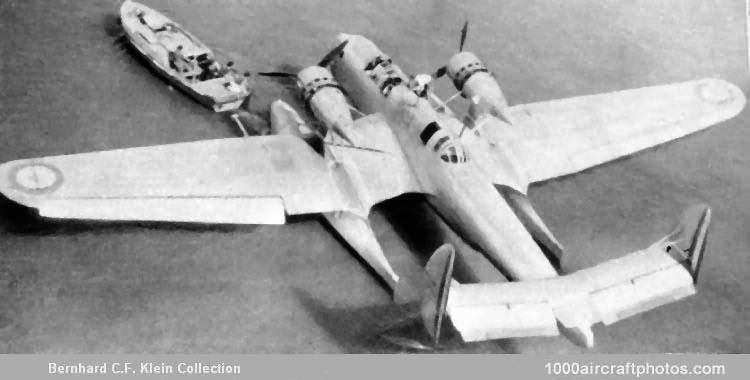The fuselage accommodated six crew members, with tandem dual controls on the port side for pilot and co-pilot, a bombardier-navigator's compartment in the extreme nose with a 0.295 in (7.5 mm) Darne machine gun on a flexible mount, a radio-operator's compartment immediately aft of the co-pilot, a flight engineer's station aft, and a dorsal gunner's position at the extreme end of the raised upper fuselage decking with a 0.787 in (20 mm) Hispano-Suiza 404 cannon in a powered turret.
A ventral gun was provided, this being a 7.5 mm Darne machine gun which fired through a hatch in the rear fuselage step. The bomb-bay occupied the entire lower section of the fuselage between the navigator's station and the dorsal gun turret, this accommodating either five 518 lb (235 kg) or three 904 lb (410 kg) bombs. Alternatively, two 1,477 lb (670 kg) or 1,653 lb (750 kg) torpedoes could be carried.
Built at Saint Nazaire, the L.N.10-01 was flown for the first time from the Loire Estuary on July 21, 1939, powered by two 1,600 hp Gnome & Rhône 14R 0/1 fourteen cylinder radial air-cooled engines. On December 10, 1939, the French Admiralty advised the Ministère de l'Air that no production order would be placed for the L.N.10 or its competitors owing to the decision to use land-based aircraft for the torpedo-bombing role, and it was requested that the completed machines be delivered to Saint Raphaël for experimental purposes.
At Saint Raphaël inadequate stability displayed during trials necessitated the return of the L.N.10-01 to Saint Nazaire for enlargement of the endplate vertical tail surfaces. Late in May 1940, the floatplane was flown to Hourtin to complete its official trials, and was being overhauled there when German forces occupied Bordeaux late in the following month. The floatplane was, therefore, scuttled to prevent it falling into German hands, and at that time it had logged 150 flying hours."
Span: 88 ft 7 in (27.00 m)
Length: 59 ft 4.5 in (18.10 m)
Height: 21 ft 11.75 in (6.70 m)
Wing area: 968.752 sq.ft (90 sq.m)
Weight empty: 18,739 lb (8,500 kg)
Loaded weight: 30,743 lb (13,945 kg)
Max speed: 267 mph (430 kmh) at 14,760 ft (4,480 m)
Cruise speed: 174 mph (280 kmh)
Service ceiling: 22,965 ft (7,000 m)
Climb: to 16,400 ft (5,000 m) 22 min
Range: 2,050 mls (3,300 km)
